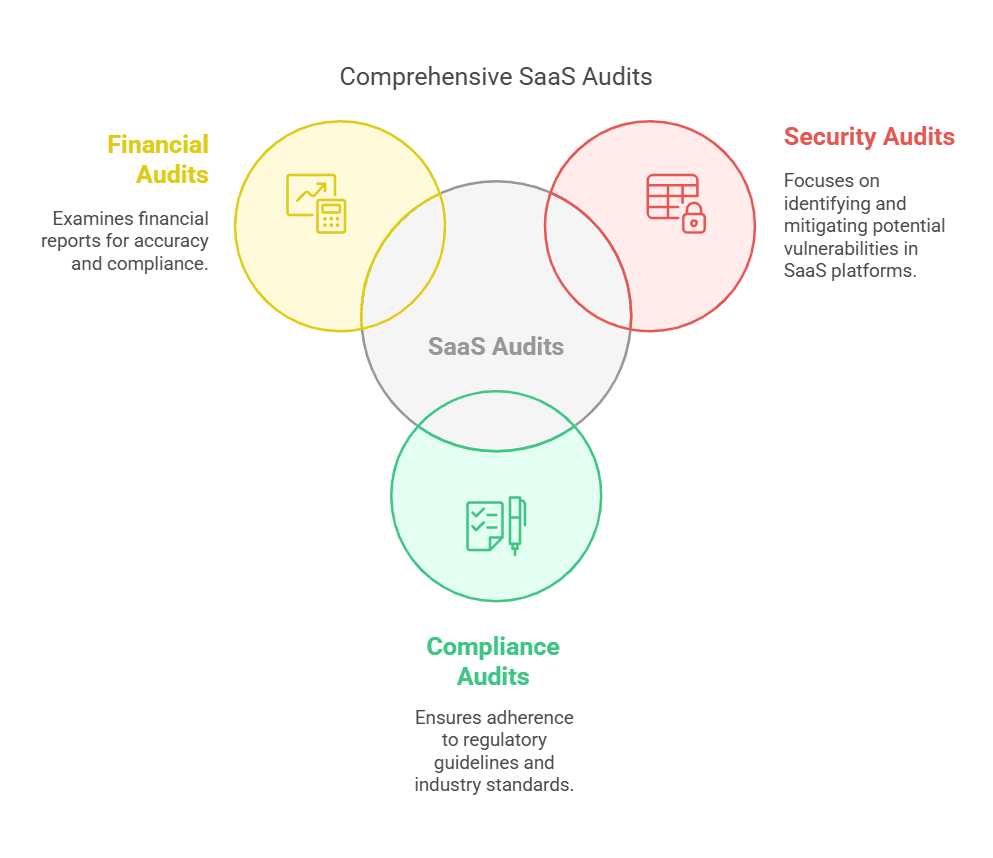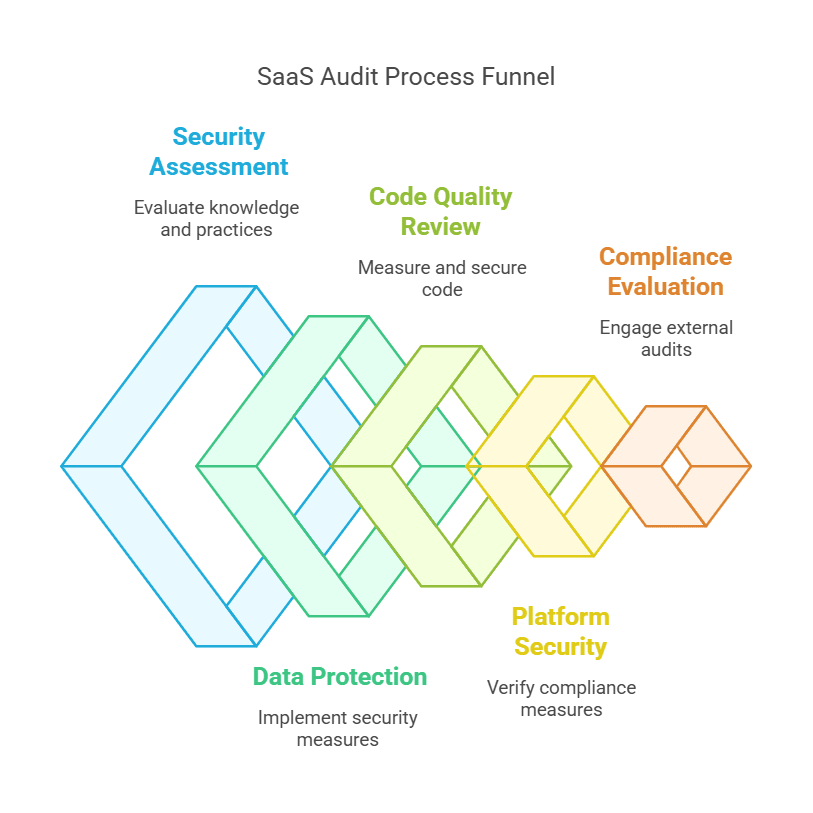SaaS Audits: Why They're the Next Big Thing in Financial Due Diligence
Introduction
Are you ready to reclaim your SaaS budget and transform your SaaS stack into a savings engine? Did you know that up to 32% of SaaS spending is wasted? That's right, a significant portion of your budget could be leaking away due to underused tools and wasted licenses.
In today's fast-paced business environment, Software as a Service (SaaS) has become indispensable. However, managing SaaS tools effectively is a growing challenge for finance, IT, and software asset management leaders. This is where SaaS audits come in.
A SaaS audit is a thorough assessment of your organization's SaaS landscape, covering security, compliance, and financial aspects. It's not just about cutting costs; it's about ensuring your SaaS investments deliver the best possible return on investment (ROI) while maintaining security and compliance.
This guide will walk you through everything you need to know about SaaS audits, including:
- What a SaaS audit is and why it's essential.
- The different types of SaaS audits.
- A step-by-step guide to conducting a SaaS audit.
- The tools and technologies that can streamline the audit process.
- How to overcome common challenges in SaaS audits.
- Real-world examples and case studies.
- The future of SaaS audits.
Understanding SaaS Audits
What is a SaaS Audit?
A SaaS audit is a structured review of your organization's SaaS applications and related processes. This review includes evaluating security measures, ensuring regulatory compliance, assessing financial spending, and monitoring performance. It’s a comprehensive health check for your SaaS ecosystem. Different audits address specific concerns like security, compliance, or financial optimization.
Why are SaaS Audits Important?
SaaS audits are critical for several reasons:
- Security: Identify potential weaknesses and vulnerabilities in your applications, protecting against data breaches and cyber threats.
- Compliance: Ensure your organization meets regulatory requirements such as SOC 2, HIPAA, and GDPR.
- Financial: Uncover wasted spending, optimize license utilization, and maximize ROI. AlphaSaaS can help you achieve up to 32% cost savings by identifying underused tools and wasted licenses.
- Operational Efficiency: Ensure your SaaS platform operates at peak efficiency, identifying bottlenecks and areas for improvement.
Unique Aspects of SaaS Audits
SaaS audits differ from traditional audits due to the unique characteristics of SaaS:
- Recurring Payments: Monthly or annual subscriptions require careful tracking of revenue and expenses.
- Long-Term Payment Structures: SaaS agreements often span several months or years, making revenue deferral complex.
- Different Financial Reporting Structures: SaaS balance sheets often lack traditional assets like inventory, requiring different accounting approaches.
Types of SaaS Audits
There are primarily three types of SaaS audits, each focusing on a different aspect of your SaaS environment:

SaaS Security Audits
Definition: A SaaS security audit is a comprehensive assessment of your SaaS platform's security measures.
Goals: Identify potential vulnerabilities that malicious actors could exploit.
Key Areas to Assess:
- Employee security awareness.
- Data protection (at rest, in use, and in transit).
- Application security.
Practical Steps:
- Vulnerability Scanning: Use automated tools to identify known security flaws.
- Penetration Testing: Simulate cyber attacks to evaluate the application’s ability to withstand threats.
- Secure Code Review: Examine the application's source code to detect vulnerabilities at a granular level.
Best Practices:
- Regular and systematic testing and auditing.
- Continuous learning and adaptation to new security threats.
- Encouraging a security-oriented culture within the organization.
SaaS Compliance Audits
Definition: A compliance audit checks if an organization complies with regulatory guidelines.
Objectives: Ensure adherence to relevant laws, regulations, and industry standards.
Common Compliance Standards:
- SOC 2: Securely manage data to protect the organization's interests and clients' privacy.
- HIPAA: Compliance for healthcare-related data.
- GDPR: Adherence to data protection regulations for handling EU residents' personal data.
Steps for Conducting a Compliance Audit:
- Preparation: Develop a compliance program and documentation.
- Assessment: Conduct internal and external audits to check compliance.
- Reporting: Generate audit reports detailing strengths and shortcomings.
- Remediation: Correct process and policy shortcomings based on the audit report.
SaaS Financial Audits
Definition: A financial audit is a thorough examination of an organization's financial reports.
Objectives: Determine whether financial reports are accurate and compliant with financial reporting frameworks.
Key Components:
- Revenue: Subscriptions, upgrades, and customizations.
- COGS: Cost of creating and delivering goods.
- Operating Expenses: Salaries, rent, utilities, and other expenses.
- Income: The company's bottom line or net income.
- Recognized/Deferred Revenue: Earned vs. expected revenue.
Preparing for a Financial Audit:
- Invest in advanced accounting software and a team of professional accountants.
- Organize and track all financial documents in a central storage location.
- Automate procedures to minimize errors and streamline accounting.
- Reconcile documents regularly (monthly or quarterly).
Conducting a SaaS Audit: A Step-by-Step Guide
Conducting a SaaS audit involves a systematic approach. Here's a step-by-step guide to help you through the process:

1. Planning and Preparation
- Define the audit's scope and objectives.
- Assemble a skilled audit team, including internal/external auditors and IT professionals.
- Select appropriate security standards and frameworks.
2. Assessing Security Intelligence
- Evaluate your workforce's security knowledge and practices.
- Assess your customers' security awareness.
- Provide security awareness training to address any gaps.
3. Data Protection Measures
- Data at Rest: Ensure data is protected by firewalls, antivirus programs, and encryption. Cloud providers should store data across multiple locations to reduce data loss.
- Data in Use: Implement authentication and access control measures. Track and report any suspicious activity.
- Data in Transit: Transmit data through an encryption platform. Ensure data is validated, sanitized, and follows a strict retention policy.
4. Code Quality and Secure Development
- Measure code quality in terms of efficiency, maintainability, reliability, and security.
- Follow secure coding practices and software development life cycles.
- Address common vulnerabilities like buffer overflows and SQL injection.
5. Platform Security
- Verify the security measures of the application's platform.
- Ensure compliance with appropriate safety standards.
6. Compliance Evaluation
- Review compliance audit checklists.
- Engage professional security teams for external audits. Astra Security’s engineers can quickly audit your application and help your development team patch it.
- Implement corrective actions for any identified risks or deficiencies.
7. Reporting and Remediation
- Create a comprehensive audit report detailing findings and risk levels.
- Develop and implement an action plan to address vulnerabilities.
- Conduct follow-up audits to ensure the effectiveness of implemented measures.
Tools and Technologies for SaaS Audits
Several tools and technologies can streamline and enhance the efficiency of SaaS audits:
-
Automated Vulnerability Scanners: Identify potential vulnerabilities within applications.
- Popular Tools: Astra Vulnerability Scanner.
- Benefits: Efficiency and comprehensive testing.
-
Compliance Management Software: Automate workflows and stakeholder notifications.
- Features: Stakeholder notifications and centralized record systems. Vendr can also trigger stakeholders’ notifications to complete open tasks or deliver regular reminders to ensure everything gets done.
-
AI-Powered SaaS Management Platforms: Uncover hidden SaaS wastage and optimize spending.
- Features: App discovery, license optimization, and usage analytics.
- Example: AlphaSaaS helps you assess your SaaS stack and generate desired ROI. It can help you achieve up to 32% cost savings.
-
Cloud Security Posture Management (CSPM): Automate security misconfiguration remediation.
-
Financial Management and Accounting Software: Track financial data comprehensively.
- Capabilities: Provides advanced accounting capabilities.
- Integration: Allows for comprehensive data tracking.
Overcoming Challenges in SaaS Audits
- No Existing Audit Trail: Implement systems for chronological event tracking.
- Incomplete or Inconsistent Data: Centralize data storage and standardize formats.
- Differing Understandings of Control Requirements: Ensure team alignment.
- Insufficient Time to Prepare: Allocate adequate time for auditing.
- Failure to Learn from Mistakes: Use audit results to drive effective changes.
Real-World Examples and Case Studies
- Successful Auditing Examples: Companies avoiding breaches through regular audits.
- Lessons Learned: Financial and reputational consequences of neglecting audits.
- TinyCheque Case Study: A SaaS audit that transformed a security SaaS platform, unlocking $1M+ in new sales and boosting customer retention by 40%.
The Future of SaaS Audits
Emerging Trends:
- AI and machine learning for audit automation: Increased use in audit automation. TinyCheque uses AI to detect bottlenecks, inefficiencies, and security vulnerabilities.
- SaaS Supply Chain Security: Increased focus on SaaS supply chain security.
- DevSecOps: Integration of security into the DevOps pipeline (DevSecOps).
- Continuous compliance monitoring: Growing importance of continuous compliance monitoring.
Preparing for the Future:
- Adapt to new security threats and technologies.
- Invest in ongoing education and training.
- Foster a proactive security culture.
Why AlphaSaaS Makes SaaS Audits Effortless and Impactful
AlphaSaaS takes your SaaS audit to the next level, providing an AI-powered, streamlined solution to identify app redundancies, usage inefficiencies, and hidden SaaS wastage. With AlphaSaaS, you can:
- Gain a clear overview of your entire SaaS landscape.
- Uncover underutilized apps and eliminate redundant licenses.
- Automate license optimization and ensure your team has the right tools without overspending.
- Generate actionable insights with usage analytics and health cards — unique in the market!
Ready to transform your SaaS stack into a savings engine? AlphaSaaS helps you reclaim your budget and achieve up to 32% cost savings, without compromising on productivity or security.
Don’t just audit — optimize with AlphaSaaS!
Conclusion
SaaS audits are not just a best practice; they are a necessity for modern businesses. They provide a structured approach to identifying vulnerabilities, ensuring compliance, and optimizing SaaS spending. By prioritizing regular security audits and adhering to established standards, businesses can significantly enhance their application's security posture and earn their users' trust.
Ready to maximize your SaaS potential? See how AlphaSaaS can save you 30% in minutes. Don't let your SaaS budget leak away – reclaim it with a comprehensive SaaS audit.

Nehan Mumtaz
Nehan Mumtaz, an M.Tech in Computer Science, is a published author in IEEE and leading journals. Her research spans machine learning and distributed systems, bridging theory and application. A mentor and tech enthusiast, she’s passionate about advancing innovation and exploring the future of AI and computing.